Interior Concrete Flooring
Concrete interior floors can be finished in many ways.
Concrete isn’t just for the garage and sidewalks. Interior concrete floors are gaining popularity throughout Virginia for their style and strength. Concrete interior floors can be finished in many ways with aggregates, stains, epoxy, and stamped patterns.
Depending on your style, your concrete floors can look like marble, granite, or even wood.
We install interior concrete flooring in the Alexandria, VA area with a focus on quality and customer service. Thinking about concrete in your kitchen, living room, or basement? Here’s why homeowners love concrete floors.
Interior Concrete Flooring
Concrete interior floors can be finished in many ways.
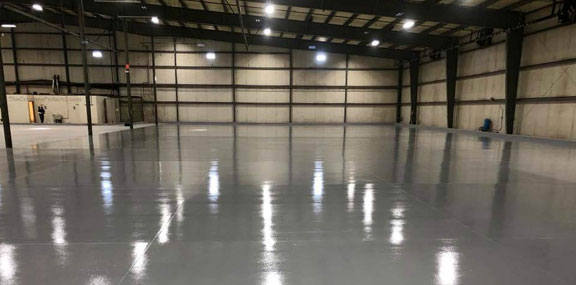
Don’t assume all concrete is bland and gray. There are almost endless ways to change the appearance of concrete, especially inside the home. You may want your concrete floors to resemble a natural and high-end product like wood or stone. You can also choose a hue and pattern that matches your decor or something fun for a child’s play room.
Our Alexandria concrete contractors can help you achieve the look you want with a wide variety of options.
Decorative Concrete Overlays
Epoxy offers an affordable and low upkeep flooring solution.
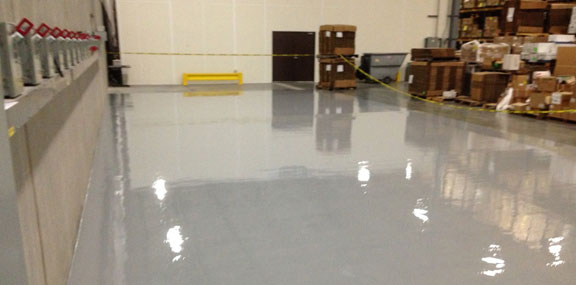
If your existing hard-surface floor is damaged or unattractive, a concrete overlay can be the solution. A concrete overlay is applied over an existing slab to give you a completely new surface.
Your new concrete floor can be customized in many ways. Stamped concrete interior floors are very popular in Alexandria. Stamped concrete involves applying a texture mat to create a textured pattern. Stamped concrete can look just like brick, wood, slate, and more. We combine coloring techniques to achieve the look you want.
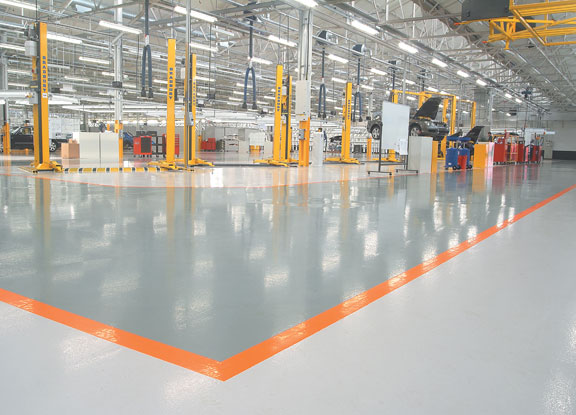
Interior Concrete Colors
Epoxy offers an affordable and low upkeep flooring solution.
You probably don’t want gray concrete floors in your home. You may not know there are many ways to add color to concrete floors.
Interior concrete paint is one option for vibrant colors. If you want to paint the concrete, it must be repaired first. Our contractors will repair any holes or cracks for a smooth, seamless surface. Painted concrete cannot be achieved with regular interior or exterior paint. In fact, paint for concrete isn’t actually paint. We use water-based acrylic stains and dyes that are designed for concrete for an opaque or semi-translucent effect. These specially formulated paints breathe to prevent moisture in the concrete from becoming trapped.
Water-based stains add permanent color to your floor by penetrating the surface of the concrete. Stains will react chemically with the calcium hydroxide in concrete and never wear off. Depending on the stain, you can achieve an opaque to translucent effect. Stained concrete interior floors have brighter, more vibrant colors when a water-based stain is used. Water-based stains also come in many more colors than acid.
Concrete dyes are another option. Dyes are nonreactive and add color by penetrating the concrete. Concrete dyes can achieve a translucent or monotone effect on your floor. Solvent-based dyes are best for a uniform color. If you want variegation and marbling like a chemical stain, we will use a water-based dye.
Epoxy coatings can also be used to add color. Epoxy takes your concrete floor to the next level with a tough yet beautiful commercial-grade surface. Epoxy can be used to create stunning metallic floors and the appearance of natural marble or granite.
If you are going to pour new concrete or add a concrete overlay, integral color is an option. This involves adding color to the concrete when it is mixed. Integral color achieves a permanent and uniform color. Colored hardeners can also be used with fresh concrete. Hardeners come in a powder and are broadcast onto poured concrete then worked into the surface. Hardeners will only color the surface layer of the concrete. This produces a more intense color than integral color.
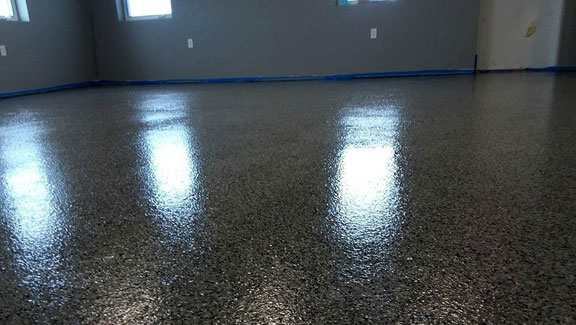
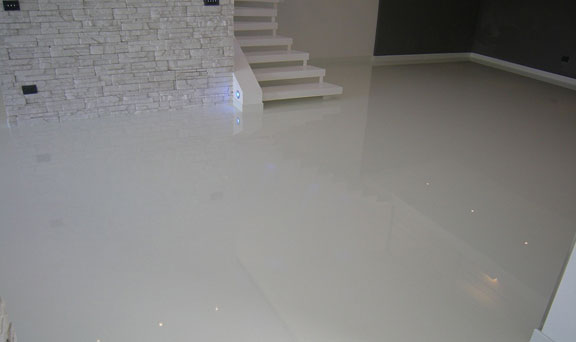
Why Concrete Interior Floors?
Here’s why you should give concrete some thought.
Forget what you think you know about concrete. It’s actually far from boring and can be used to create stylish and affordable indoor floors. If you’re not sold on concrete floors, here’s why you should give concrete some thought.
- Concrete floors can be finished with aggregates, colors, stains, and more. You can easily create the look you want.
- Concrete can be customized to achieve the surface texture you want. It can be smooth, troweled, or polished. It can also be scored or stamped to create patterns like tiles or to mimic wood planks.
- Concrete is a great choice for radiant heating because it absorbs heat for lower energy costs.
- Your concrete floors will repel water when properly sealed.
- Concrete is eco-friendly. Interior concrete floors will not deplete natural resources. They do not require as much energy to produce as other flooring Concrete is also poured locally. Concrete can even be recycled and there will be no need to throw away waste like underlayment.
- Interior concrete floors are very easy to clean. When sealed or treated, you will not need to worry about stains, allergens, or odors.
- Interior concrete floors improve indoor air quality. Concrete inhibits mildew, mold, and odors. It does not have harmful VOCs and there are no-VOC sealers available. It will not trap allergens, either. This makes concrete a good choice for allergy sufferers.
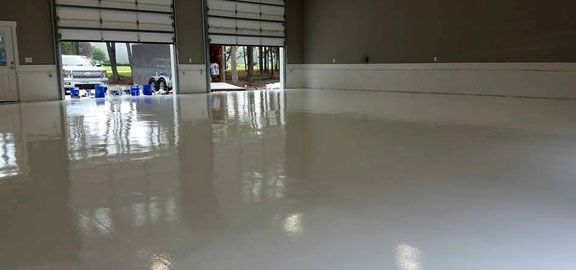
Interior Concrete Sealer
Tinted sealers offer a low-cost way to color concrete in your home.
A sealant doesn’t just protect your concrete floor from stains. It can also be used to add a semi-transparent and subtle color. Tinted sealers offer a low-cost way to color concrete in your basement or home.
Always work with a professional contractor if you want a sealer applied to concrete with a decorative finish. Stained concrete, overlays, polished, and dyed concrete may react with a sealer. This can lead to bleeding & blistering if the wrong product is used..
FAQ
Have some question about related services
Do you have questions about installing interior concrete floors in your home? Our Alexandria concrete floor contractors are always here to answer your questions. Here are the most common questions we receive from customers.
Are Concrete Floors Prone to Cracking?
All concrete cracks. The most common cracks are shrinkage cracks. These tiny cracks occur as the concrete cures and due to changes in temperature. Concrete can also develop more serious structural cracks that indicate a bigger problem. If your concrete has cracks, our contractors will repair the cracks prior to applying a finish.
Are Concrete Floors Slippery?
Concrete floors can be slippery, depending on the finish. There are also many ways to add create a safe, non-slip surface. Polished concrete floors are usually no slicker than regular concrete when dry and clean. Epoxy coatings are slicker than polished concrete unless an aggregate is added.
Are Concrete Floors Damp and Cold?
While concrete can be cold, it is no more cold than natural stone or ceramic tile flooring. Unlike other flooring options, concrete does absorb heat. Your concrete floors can store and radiate heat. Many homeowners choose to embed radiant heating cables in the concrete to keep the floors toasty warm during the cold months.
Your concrete floors will not be damp unless they are not well insulated. This can also happen if the subgrade is poorly drained. Vapor barriers are installed under concrete slabs in newer homes to prevent this problem.
Are Decorative Concrete Floors Expensive?
Decorative concrete floors are much more affordable than other high-end floor solutions. The cost of concrete is much lower than marble, slate, ceramic tile, and hardwood floors. Skilled contractors can even mimic the look of expensive materials with concrete at a fraction of the price.
Remember that concrete floors will far outlast low- and mid-priced flooring options like laminate, vinyl, and carpet. This means concrete isn’t just cost-effective to install; it also offers long-term cost savings.
